
 |
| Elliott Sound Products | Electronic Fuses |
 Main Index Main Index  Articles Index Articles Index |
Fuses have been used to protect electrical and electronic circuits from the very beginning of electrical equipment being employed. Mostly they do a pretty good job, but they are rarely fast enough to protect electronic parts such as transistors or MOSFETs from a serious overload. A semiconductor will almost always fail well before the fuse has had time to act, pretty much a perfect example of Murphy's law in action. There's a great deal of useful information in the article How to Apply Circuit Protective Devices. This article was contributed back in 2009, and shows most of the things you need to know about fuses and miniature circuit breakers.
Circuit breakers are (sometimes) an improvement over a simple fuse, but usually only if they have a magnetic trip mechanism that acts very quickly in the presence of a severe overload. All protective systems introduce some loss in the circuit, and the resistance of a variety of fuses are shown in the article and in the following section. This includes the resistance when cold (25°C) and at rated current. Fuses below 3.15A dissipate about 1.6W at full rated current, and higher rated fuses dissipate up to 2.5W. This means that they run fairly hot if used at their design current rating continuously, but this is rarely the case in most circuits.
Many circuits draw significant 'inrush' current (when power is first applied), as transformers settle down to steady state conditions and/ or as filter capacitors charge to their operating voltage. Because of this, it's often necessary to use a 'slow blow' or delay fuse, that is designed to handle a much higher than normal current for a short period. Like all fuses, if the current is only fractionally above the fuse rating, it can take a long time before it 'blows' by going open circuit. It's unrealistic to expect a wire fuse to fail if the current is (say) only 1.1 times the rated value (1.1A for a 1A fuse). In general, expect any fuse to fail within around 1-2 minutes with a current of 1.5 times the rated value.
This is quite alright for equipment with a high thermal mass, such as a transformer or motor, but it's inadequate to protect a transistor that's already at its peak operating power (so the die temperature is at or near the maximum allowable). As a result, most electronic equipment that uses fuse 'protection' is not actually protected at all. The fuse(s) only ensure that a serious fault condition won't cause additional serious damage, including the possibility of fire.
Enter the electronic fuse (or e-fuse). These can be set up to trip at a very specific current, and if it's exceeded (even by a few milliamps) the e-fuse will disconnect the load. Ideally, it will remain 'open' even if power is disconnected and re-applied, but that requires battery backup, which is very uncommon. Electronic fuse ICs are available (often with a host of additional features), but most are only available in SMD (surface mount device) packages.
The idea of this article is to show a few options that can be used at (almost) any voltage and current, and with a fairly well defined trip current. Some are much better than others in this respect, and using a resistive 'current detector' is more reliable than utilising the RDS-on of a MOSFET. This is commonly used in dedicated 'e-fuse' ICs, but these have temperature compensation to ensure predictable results.
Despite the very accurate detection thresholds available with electronic fuses, the 'traditional' wire fuse is far from being 'dead' technology. They are still the most cost-effective option where you need to manage the risk of fire (or further destruction of electronics), but their limitations have to be understood. This is why projects such as ESP's Project 33 Loudspeaker Protection circuit exist. While a pair of e-fuses could easily detect a fault condition and disconnect the load if the current exceeds a preset limit, it's not a simple alternative.
The circuits shown here are intended to provide examples, and are not construction projects. There are countless other circuits (including many specialised ICs) that can be used, but not all of them are useful for DIY (some are not useful at all IMO). An e-fuse that requires you to press a button to turn the circuit on is not helpful, and doubly so if it has no turn-off mechanism. There is one very common circuit (it's all over the Net) that uses this, and it has been deliberately left out because it's not a good idea (and many people who built it found it doesn't work). An e-fuse should be active when the power is turned on, and if tripped it must remain so until a power-on reset. If the fault still exists, it will trip again.
Electronic fuses can be a viable alternative to a thermal-magnetic circuit breaker. They are a great deal faster, and can be set for an accurate upper limit that may be well below anything offered by circuit breakers. For example, if your circuit needs 100mA, but even 120mA indicates a fault, an electronic fuse (set for 110mA for example) is the only option. No wire fuse or circuit breaker offers the same level of precision and speed.
Because they are so widely used (and the table will be referred to several times in this article), I've included this table which is shown in the How to Apply Circuit Protective Devices article. This is a useful reference table, and some of the values can be directly transferred to an 'equivalent' electronic fuse.
| Rated Current Amps | Interrupt Current Amps (Max) | Resistance, Ohms 0A Rated A | Voltage Drop At Rated Current | Power Dissipation At 150% Current (W) | |
|---|---|---|---|---|---|
| 0.315 | 35A @ 250Vac | 880 m | 4.13 | 1.300 V | 1.6 |
| 0.4 | 277 m | 3.00 | 1.200 V | 1.6 | |
| 0.5 | 206.5 m | 2.00 | 1.000 V | 1.6 | |
| 0.63 | 190 m | 1.03 | 650 mV | 1.6 | |
| 0.8 | 120.3 m | 300 m | 240 mV | 1.6 | |
| 1.0 | 96.4 m | 200 m | 200 mV | 1.6 | |
| 1.25 | 70.1 m | 160 m | 200 mV | 1.6 | |
| 1.6 | 52.8 m | 119 m | 190 mV | 1.6 | |
| 2.0 | 41.6 m | 89.5 m | 170 mV | 1.6 | |
| 2.5 | 33.4 m | 68.0 m | 170 mV | 1.6 | |
| 3.15 | 22.4 m | 47.6 m | 150 mV | 2.5 | |
| 4.0 | 40A @ 250Vac | 16.5 m | 32.5 m | 130 mV | 2.5 |
| 5.0 | 50A @ 250Vac | 13.7 m | 26.0 m | 130 mV | 2.5 |
| 6.3 | 63A @ 250Vac | 9.5 m | 20.6 m | 130 mV | 2.5 |
The table shown above is adapted from a Littelfuse datasheet (Axial Lead & Cartridge Fuses 5 × 20 mm > Fast-Acting > 217 Series) for fast-blow glass fuses. I've shown the values that are most likely to be used in typical electronic projects, but the complete table has a lot more information and covers fuses from 32mA to 15A. I added the column that shows resistance at maximum current (copper wire is assumed), and it works out that the fuse wire temperature is around 300°C at full rated current.
While there are many different topologies, the basic principles are usually very similar. We need a way to detect the actual current flow, and if it exceeds a preset threshold, the load should be disconnected with as close to zero delay as possible. Additional circuitry can be included to allow very brief excursions beyond the preset value (analogous to a delay (slow blow) fuse), or in some cases, the fuse is designed to limit the current to a preset maximum for a few milliseconds. If the over-current condition is maintained for longer than the programmed maximum, the fuse then disconnects the load from the power source. This is a feature of some e-fuse ICs.
For the most part, this article will concentrate on discrete circuitry rather than 'COTS' (commercial off-the-shelf) products. This is mainly because the internal circuitry of commercial ICs is very complex, and most are not designed for high voltages, although there are exceptions. Because these ICs are virtually all SMD parts, they are difficult to experiment with because breadboards and 'lash-up' circuitry is usually not possible without using a PCB designed for the specific device. Some even use LCC packages (leadless chip carrier), and they don't play well with any experimenter construction methods.
The most obvious requirement is a way to monitor the current. While a resistor seems like a bad idea, remember that fuses have resistance too - if it were otherwise the wire wouldn't be able to get hot and melt! (See Table 1.) The resistance should be as low as possible, but there are limits - if it's too low, the voltage across the resistor will be too low to be useful for anything. Likewise, if it's too high, the voltage drop may be excessive. If we aim for a voltage drop of 100mV at rated current, that won't upset most circuits and it's enough to be able to get reliable detection. This is actually less than most wire fuses, so it's not a bad compromise.
Once the voltage across the detector (current transformer, Rogowski coil (not covered here), resistor or MOSFET channel resistance for example) exceeds the predetermined value, the circuit must disconnect the load, and just as importantly, not re-connect it when the load current falls to zero. This happens when the load is disconnected, so a latch is required to keep the circuit turned off. Unfortunately (and unlike a traditional wire fuse), the circuit will re-connect the load if power is cycled (turn it off and back on again). If the fault still exists, it will turn off again almost instantly, but doing this may cause further damage. Unlike a wire fuse, the user cannot substitute one with a higher rating, so that affords a safeguard not otherwise available. It's not especially difficult to get a turn-off time of under 10µs with only a 10% overload, something that cannot be matched by any wire fuse. However, this does come with some caveats! All circuitry takes some time for conditions to stabilise, and in some cases the circuit may not be able to turn off at all if the fault occurs before the circuit is ready.
There are countless different ways to configure an e-fuse. There are many circuits shown on-line, and (as always) some are good, and some are completely useless. Unless you build (or simulate) the results, it's very difficult to know if a particular circuit will work or not. There are many interdependencies in all electronic circuits, and if something goes wrong it can do so with undesirable consequences (note careful use of understatement!). If your circuit relies only on an electronic fuse with no backup, you can make matters far worse than they would be if you just stayed with a wire fuse in the first place.
An e-fuse is not the same as a current limiter. Some e-fuse ICs combine the two functions, and a few circuits that claim to be an e-fuse are current limiters, not fuses. A current limiter is a very different application, and while it may save some electronics from short-term problems, the current limiting circuitry is often subjected to very high dissipation if the load develops a short circuit. Current limiting isn't covered here, because it's not equivalent to a fuse (electronic or otherwise).
A resistor is simple, but you do need to ensure that it's sized appropriately, both in value and power dissipation. Ideally, the resistor will have a 'burden' (voltage drop) of no more than 100mV, but this too depends on the application. A 100mΩ (0.1 ohm) resistor drops 100mV with a current of 1A, and dissipates 100mW. This is less than a 1A wire fuse at full current (200mV burden, 200mW dissipation). A resistor is suitable for AC or DC, but with AC there's a need for full-wave rectification, which is a problem at very low voltages. It also makes the circuitry more complex.
A better option for AC electronic fuses is a current transformer (see Transformers, Section 17 for information on these). Because the output impedance of a current transformer is very high, rectification can be done with four low current diodes (e.g. 1N4148) with very little loss of accuracy, making the rest of the circuitry much simpler. Disconnecting AC loads is more problematical, and ideally you'd want to disconnect at the instant an overload condition occurs. If the mains switch is a TRIAC, it won't disconnect until the mains waveform passes through zero, which may allow a half-cycle to exceed the limit by a great deal. Very short duration high current pulses are permissible, but if beyond the limits of the TRIAC used it will fail - short circuit!
For example, a BT139F-600 TRIAC has a steady state current capability of 16A RMS, and can handle up to 145A for one cycle at 50Hz. You can (usually) expect a dead short across the mains to be within that limit, but that depends on the circuitry, the impedance of the mains wiring, etc. If you expect the continuous (or peak) current to be higher, you'll need a higher current TRIAC (e.g. BTA25, 25A, 600V, 250A peak). A MOSFET or hybrid (MOSFET plus electromechanical) relay can also be used, but that's a more expensive option. Most AC circuits are protected by circuit breakers (ideally thermal-magnetic types), and an e-fuse would only be used for particularly sensitive circuits (but you still need a fuse or circuit breaker in case of internal failure).
An alternative detection scheme is to use a Hall effect sensor. These come in two versions, with the most common being sensitive to a magnetic field that's vertical to the plane of the IC body. There are also 'planar' versions, which can simply be placed above a PCB track, and these are sensitive to a magnetic field that's parallel to the IC body. Most are designed for high current, although 'conventional' sensors with a magnetic circuit (iron, ferrite, etc.) can be used to detect low currents accurately. An example is shown in Project 139 (Mains Current Monitor). These sensors can be used with AC or DC, unlike a current transformer that only works with AC.
Although these sensors are a great option for very high currents or where little or no voltage drop across the fuse is permissible, it's not an option that will be covered here. This is because the sensors are generally fairly specialised, and some are too expensive. In addition, there is still a requirement for a switching circuit, which will nearly always impose a small voltage drop. The exception is a relay, but that makes the system electro-mechanical, which barely qualifies it for the name 'electronic fuse'. In such cases, a thermal-magnetic circuit breaker may be a better option.
As stated above, a resistor is a reliable and versatile detector. However, there are some methods that may come as a surprise, such as the reed switch shown below. I selected a reed switch at random from a box of them I acquired for next to nothing, and wound 10 turns of telephone/ bell wire around the middle. It trips at almost exactly 2A, and the result is 100% repeatable. This has the advantage that there is very little resistance in the circuit (heavier gauge wire would be used for higher current), but there is a small delay because it's a mechanical contact. Since (at least with the switch I tested) it requires 20 ampere-turns (2A, 10 turns) to operate, it can be configured for almost any current you like. Anything over 20A would be a challenge though, as that implies less than one turn. Positioning the coil along the body of the switch will provide some control over the trip current.
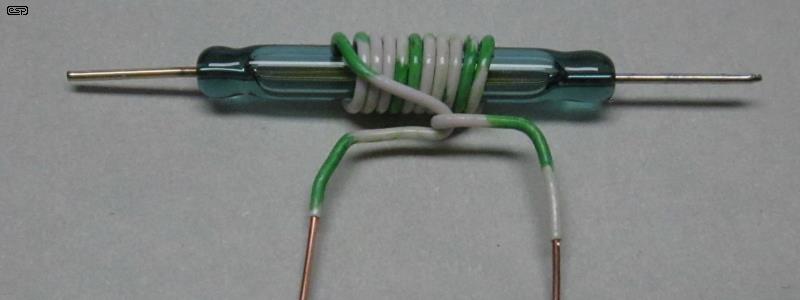
The advantage of this technique is that the electronic fuse circuitry is isolated from the voltage source being monitored, although we still have to provide a mechanism to turn off the supply. Once disconnected, it also has to remain off until the circuit is reset or the supply is cycled off and on again. Supply interruption methods are described further below. This information is provided more for interest's sake than any suggestion that a reed switch is the ideal sensing method. As always, it depends on the application, and the optimum detection method varies accordingly. I've only seen one circuit that used a reed relay during my search, but it's completely different from the circuit I've shown.
You will find very little anywhere about using a reed switch as a current sensor, but they are quite precise and very fast. The sensitivity is adjusted by the number of turns and the position of the coil along the length of the reed switch glass body. In general, this approach is ideal for moderate current, as anything over 5A starts to get tricky because of the low turns count. With those I've tried, 5A operation is reliable with four turns (20A/T), and adjustment (e.g. for 6A) is obtained by moving the coil along the body so it's not centred over the contacts. The coil should be fixed in place with tape or a suitable adhesive (UV-cure adhesive is ideal).
This is an application that has received almost no attention from anyone else, which I find a little strange. With the addition of a small SCR to latch the over-current 'event' and a suitable switch (which could be 'solid state' [e.g. MOSFET] or electromechanical relay) you have a simple, reliable overload detector that has close to zero dissipation in the sensor itself. This is almost the equivalent of a magnetic circuit-breaker, but can be expected to be somewhat faster and with a precise detection current.
If a relay is used as the 'disconnect' device, it should be powered from a higher voltage than its coil rating for faster operation. These are commonly used as 'efficiency' circuits, designed to reduce the coil current once the relay has activated. As shown next, you can have both - faster activation and improved efficiency.
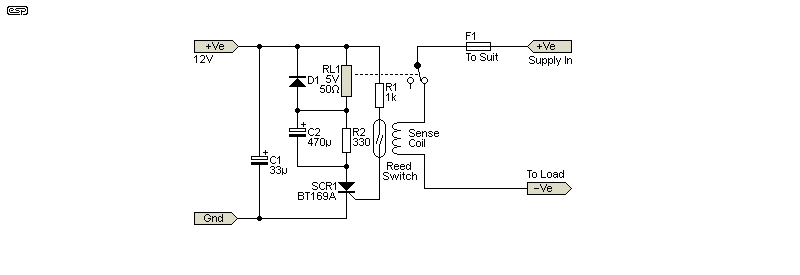
If the relay has a 5V coil as shown, you can expect its resistance to be around 50Ω for a more-or-less typical 10A relay. If you look at the specifications for any relay, you'll see that the 'must release' voltage is typically less than 20% (sometimes only 10%) of the rated voltage. A sensible compromise is 30%, so after the capacitor has charged the relay coil will have 1.5V across is. The current is reduced to 30mA, and the relay will operate much faster than normal. Where the specified operation time may be 15ms, we can halve that by using a momentary 12V supply.
Using this arrangement, the peak current will be around 180mA (normal operating current is 100mA), and the coil will get 100mA within 2ms, ensuring rapid actuation and disconnection of the load. With the continuous coil current reduced to 30mA, the power while activated is only 360mW. The activation time is determined by both mechanical inertia and coil inductance, and the 'speed-up' circuit helps to minimise the effects of both. The normally closed contacts open faster than the quoted activation time, but the difference isn't huge. This technique can be used with any of the circuits described below that use a relay.
However, you must always consider the supply and load characteristics. Electromechanical relays are not suitable if you need to break DC at more than 30V (current dependent), MOSFET and other 'solid state' relays can fail (almost invariably short-circuit). The switching device must be selected according to the supply and load.
Be aware that the circuit shown cannot operate if the 12V supply is turned off. A 'fail-safe' circuit would use the relay's normally open contacts, so the relay can't close unless power is available. This creates a new set of constraints, but the general principle isn't changed much. Many of the latching circuits shown below can also be used with a reed switch detector, so I leave the details to the reader. There is no 'Reset' facility in the above circuit, so to reset the 'fuse', turn the 12V supply off then on again.
There are some quite specific precautions that may be required, depending on the circuit used. For example, if a latching circuit requires a power-on reset (POR) to ensure it's in the proper state to be triggered, it's important that the mains power cannot be applied before the POR has completed. This is critical, because the circuit may be unstable if it's told to turn off while the POR signal is still present. Things like that can cause an otherwise reliable circuit to create much grief, and it's important to look at every possibility, however unlikely it might seem. Some potential issues are not easily covered by simulations or bench tests unless you are aware of the possibility in the first place. For example, one circuit I've seen on the Net will only trigger when the current first passes the threshold. If that point is missed (for whatever reason, including the POR issue mentioned), the circuit is inactive and your 'protected' circuitry burns up.
For particularly sensitive applications, it may be necessary to provide an auxiliary 'always on' supply to power the e-fuse. It will turn off if the mains lead is disconnected, but remain on whenever the device is connected to the mains (independent from the mains switch). Of course, the circuitry used has to be protected itself, lest a failure causes the auxiliary supply to fail. This will almost always be a wire fuse, or perhaps a fusible resistor. It's also important to ensure that the main circuitry cannot be powered on unless the auxiliary supply is operating normally.
The use of a wire fuse as an 'emergency backup' is mandatory, because there's always the possibility that a fault can occur within the electronic fuse itself. The switching device may fail, and being (usually) a semiconductor, it will fail short circuit. Relying on the die bonding wires to fail is not a good approach, as this is highly variable and in some cases may require far more current than the voltage source can provide.
By now it should be apparent that electronic fuses are not as simple as they seem. There are quite a few that rely on SCRs (silicon controlled rectifiers) or TRIACs (bidirectional AC switches), but these have problems as well. Once an SCR has turned on, it can only be turned off again by reducing the current to below that required to maintain conduction (the holding current). Most also have a minimum current to turn on (and stay on), called the latching current. If these are not properly thought out, the circuit may not function properly or may not work at all.
While using a resistor to sense the current is somewhat 'old hat', it's far more reliable than (for example) measuring the voltage drop across a MOSFET while it's turned on. This may be alright inside an IC where temperature compensation can be applied, but in a discrete circuit, RDS-on varies with temperature, which is itself a function of the load current. Ideally, the MOSFET needs to have the lowest possible RDS-on to minimise power loss (and MOSFET heating), but that makes it much harder to monitor the tiny voltage drop across the device when it's powering the circuit.
The selection of the switch is very important. Relays have the advantage that they are extraordinarily reliable and provide complete isolation of the switched circuit from the electronics, but they aren't suitable for high voltage DC. For most, this means anything over 30V DC with a current of more than a couple of amps. At higher voltage or current, there's a risk that the DC will simply arc between the contacts. Relays are also fairly slow (compared to electronic switches). If you wish to use a relay as the switch, I suggest that you also read the Relays, Selection & Usage articles (it's a two-part article). If closed contacts are used to provide current to the load, they will generally open within 5ms (longer if a diode is used and coil voltage is removed). For DC, MOSFETs are the preferred choice for a continuous current of up to 50A or so, but a heatsink is essential. SCRs and TRIACs are fine for high current AC applications, but they also need a heatsink. Anything that requires a heatsink starts to get rather large (depending on the current).
In the circuits that follow, I've specified a floating 12V supply. This isn't always essential, but it ensures that there is no interaction between the protected circuit and the power supply used for the electronic fuse circuitry. As a result, any of the DC circuits can be used with either polarity of the main supply, provided the polarity of the switch is observed. The floating 12V supply ensures that there are no polarity conflicts that could cause a short circuit under some conditions. A simple solution for a floating supply is a miniature isolated DC-DC converter. These are described further in the next section.
Because electronic fuses are usually capable of very high speed, the following circuitry should not have any large capacitors that need to be charged. Although the typical risetime of the DC is around 4-5ms if provided by a transformer and rectifier at mains frequency, some circuits may have a much faster risetime. The charge current into a capacitor is determined by the capacitance, risetime of the applied voltage, and any series resistance. The latter includes diode dynamic resistance, transformer winding resistance, and even the resistance of the mains (from the powered device back to the power station). In 230V countries, expect the mains resistance/ impedance to be around 0.8-1 ohm, or 0.2-0.25 ohm for 120V outlets). To give you an idea, a 1,000µF capacitor, charged from a source with a voltage of 50V and a risetime of 2.5ms and a source impedance of 1 ohm will draw a peak of 18A as it charges. This will trip all of the circuits shown below, although the Figure 5.1.2 'slow-blow' circuit can be tailored to handle capacitor charge current.
If the risetime is increased to 5ms, the peak current is 10A. This is still more than enough to trip the circuits shown. You must either minimise the capacitance on the load side of the e-fuse, increase the risetime, or use a delay system to ensure that instantaneous high peak currents don't trip the circuit. This rather defeats the purpose of a very fast electronic fuse. Some circuits are more amenable to applying a delay than others. It's easy with the Figure 5.1.1 circuit (see Figure 5.1.2), but harder (and less predictable) with the circuits shown in Figures 5.1.3, 5.1.4 and 5.1.5.
AC 'Solid State' relays based on TRIACs or SCRs cannot turn off until the current falls to zero. That means that you could have a serious over-current for up to 10ms (50Hz, 8.6ms for 60Hz). This may or may not be a problem, but it is something you need to understand. Should any SSR fail, it will become a short (possibly in one direction only, causing half-wave rectification of AC). It may seem silly to protect an e-fuse with a wire fuse, but it's there as a backup. If it's omitted, a fault cannot be contained should the SSR (or even an electromechanical relay) fail. The results could be catastrophic!
In this section, I have concentrated on circuits that I've been able to simulate or bench test, and that can be trusted to function reliably. This has reduced the possible examples to only a few. There are some elsewhere that might work, but without the physical parts or simulator models, it's impossible to know for certain. If I can't ensure that a circuit does what is expected of it, it doesn't get published - there are way too many examples of circuits that will not perform as claimed, and I'm not about to add to their numbers. It's quite obvious that some circuits that claim to be 'electronic fuses' are nothing more than current limiters - they are not the same thing!
Note: The circuits described are fuses and are not current limiters. None is suitable for providing a fixed limited current.
I show examples of both AC and DC electronic fuses, but for AC the only sensor I would consider seriously is a current transformer. There are ICs that can sense current, but most are only available in SMD packages, and they aren't covered in any detail. Ideally, if you build an electronic fuse, you need to be able to repair it if anything goes wrong, and many SMD parts have a very short sales cycle. The IC you buy today may not be available after only a few years. My articles span over 20 years, and I won't suggest anything that's obsolete or may become so in the foreseeable future. There are several suppliers of current detector ICs, but current transformers have been around for over 100 years and are more common now than ever before.
For the examples, I'll base the circuit on a trip current of around 5A (AC or DC). It's fairly easy to adapt any design for higher or lower current, usually with nothing more than a sense resistor change. Note that most designs require a separate power supply, since that provides for more consistent operation. However, it's also a nuisance to add, although a good option is the Mornsun B1212S-1W or an equivalent (similar tiny supplies are made Murata and Traco Power, amongst others). These are miniature DC-DC converters, with a 12V (nominal) input and an isolated 12V output. The isolation is not necessarily sufficient for mains voltages, but is fine for any circuitry powered from the secondary of a transformer. While the specifications state that the isolation voltage is 1kV, that's the test voltage - the supplies should not be operated with anywhere near that voltage differential. I've used these supplies in some 'special' projects, and I always keep a few on hand because they are so useful. They can be as small as 12 × 6 × 10mm (length × width × height in millimetres), and can be purchased for as little as AU$2.20 each.
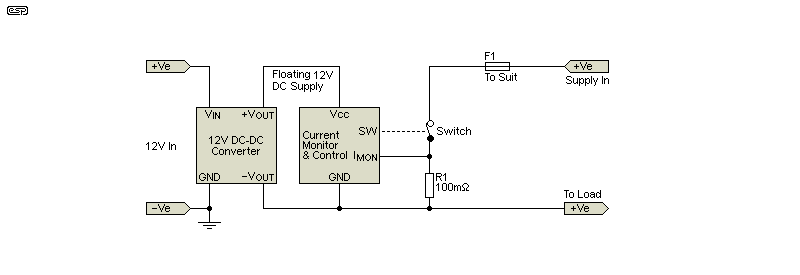
The basics are shown above. You need to monitor the current, suitable circuitry to detect an over-current fault, and a switch to disconnect the load from the power supply. The detector is shown as a resistive shunt, but you can use a Hall sensor, a current transformer (AC only) or even a reed switch as shown in Figure 3.1. The control circuit should latch, so that the switch does not close again until power is cycled. Many e-fuse circuits you may see have a 'reset' button, but this is not included in the above, nor in any of the other examples. Sometimes it's a good idea, but mostly it's not. You'll also see that a fuse is included - this is intended as a fail-safe. If the e-fuse fails to operate, you still have some protection against catastrophic failure and/ or fire.
The DC supply that powers the detector and latch circuitry should normally be floating (not referred to earth/ ground) as it will usually connect to the protected supply, which itself may or may not be referenced to ground or some other voltage. By floating the DC supply, it can be connected to any other voltage source without fear of creating a short circuit or other problem. Small DC-DC converters are available readily for under AU$10.00 each, and a single 'master' 12V supply can provide power to as many DC-DC converters as you need. Mostly, the detector will only need a few milliamps, and a 1W, 12V converter can supply 80mA. It's unlikely that more will ever be needed. All following examples show only the floating supply - the DC-DC converter isn't included.
Mostly, the switching device will be a MOSFET for DC or a TRIAC for AC. There may be situations where an IGBT (insulated gate bipolar transistor) or back-to-back SCRs are preferable, but that doesn't apply for circuits where the current is only a few amps. Even if an e-fuse is used to protect a power amplifier (for example), the average current is usually quite low. Note that if any circuit uses dual polarity supply rails, there should be a mechanism in place so that if one trips, it automatically trips the other. Dual rail circuits generally misbehave if one supply goes missing but the other remains.
This is particularly true for dual-supply audio circuits (preamps and power amps). It's essential that both supplies are turned off simultaneously, or the resulting DC offset can damage your loudspeakers. It's up to the reader to determine if the circuit selected will do that reliably, as it's not possible to cover every eventuality in this article.
These are likely to be the most common requirement, but they can still create some 'interesting' challenges. Of these, providing a reliable power-on reset (POR) is one that cannot be overlooked. Schemes that look fine (and simulate exactly as expected) can be very deceptive, and it's an area that gets scant attention in most latching circuits that you'll see. As noted earlier, ideally a circuit that includes latching will be used as a matter of course, since circuits that can 'automatically' reset are liable to cause more damage. This isn't necessarily a problem, and it depends on the application. It's also important to keep dissipated power as low as possible, as this reduces wasted power and (hopefully) means that you don't need to add a heatsink to the switching device. At high currents, there will nearly always be a need for a heatsink, but it should be as small as possible or the circuit is a nuisance to incorporate into a design.
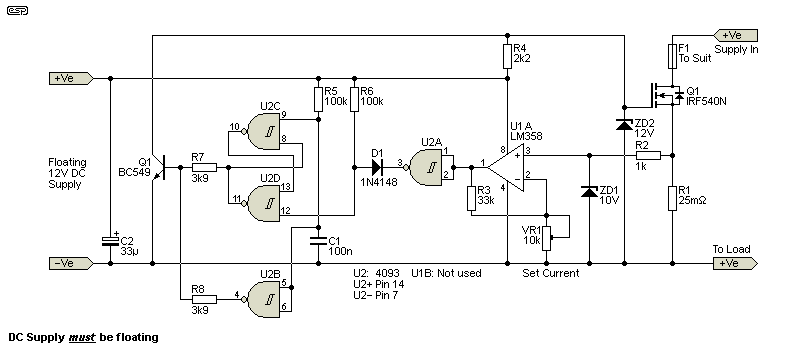
Figure 5.1.1 shows an electronic fuse that has all the required safeguards for reliable operation. U2C and U2D form a 'set-reset' latch, which is initialised by the charging of C1 when power is applied (power-on reset). The 12V floating power supply needs to turn on quickly enough (within 5ms to full voltage) to ensure that the reset works, otherwise the circuit may not turn on the load. While the POR is active, Q1 is turned on to ensure that no load current flows until the circuit is ready to function. The load can be in the positive or negative side of the switching MOSFET, and the only thing of importance is that the polarity is correct.
If the load current exceeds the preset maximum (as set with VR1), the output from U1A will exceed the threshold for U2A, which sets the latch and turns off the power (Q1 shorts the gate supply to the MOSFET's source). For a 5A load, R1 (current sense) can be as low as 25mΩ, and U1A needs a gain of about 50 to trigger U2A. The LM358 is used because they are cheap, readily available, very tolerant of supply voltage issues, and can operate normally with both inputs at (or even slightly below) the negative supply voltage. They aren't particularly fast, but a simulation shows that the circuit will trip (turning off power) within 10µs - even if the current is less than 10% above the threshold.
While the circuit may look fairly complex, there are only two low-cost ICs and a small handful of other parts. The MOSFET is selected based on the supply voltage used for the load. The IRF540N is shown as an example only, and because it has a low RDS-on, power dissipation is only 1.1W at full current (5A). There are many MOSFETs that can handle either much higher voltage or current, so that needs to be chosen to suit the application. Likewise, for lower currents, R1 should be a higher value to ensure that U1A doesn't need too much gain (around 50 is the maximum I'd recommend). The circuit's current draw from the floating 12V supply will be around 1mA or so when the load is on, rising to about 6.5mA when tripped (because Q1 has to pull the gate voltage to zero).
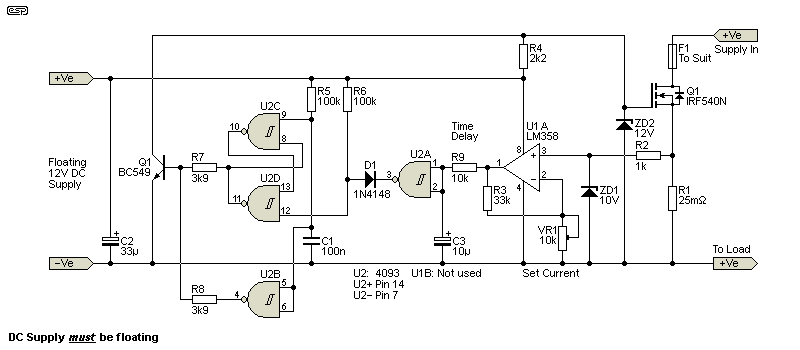
The configuration above has another useful feature. If you include the resistor/ capacitor network before U2A, the combination of R9 and the capacitor (C3) provides a 'slow-blow' characteristic. The capacitor will integrate the DC, so it can handle high peak current, provided the average is below the trip current. With R9 at 10k, you can use 33µF or more, which will allow up to 10A for one second (under 100ms with 10µF). A sustained overload of two hundred milliamps (based on a 5A cut-off) will disconnect the power in just over one second with 33µF for C3. No wire fuse or circuit breaker can match that. Most of the other circuits shown can't match that either - with most, 'slow-blow' operation isn't possible.
You can adjust the time delay section over a wide range. Both R9 and C3 can be increased in value to get a longer delay, but make sure that C3 is a low-leakage capacitor and isn't subjected to any heat source. This will increase its leakage and may adversely affect the timing. An electronic fuse that can't do its job is worse than useless. A zener diode (~3.9V, cathode to U1A.1) can be used in parallel with R9 so a severe overload will trip the circuit almost instantly. This will require some experimentation to get it right for your application.
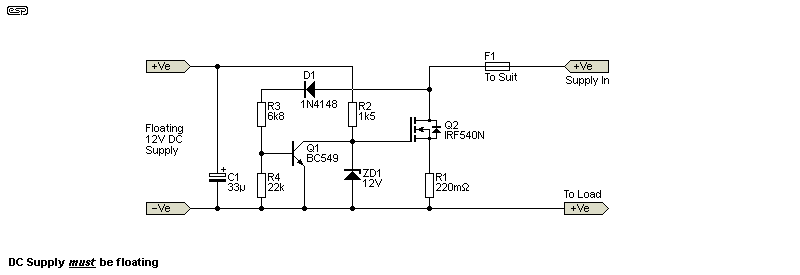
The circuit shown above appears on several websites, and its origin is unknown. It's been modified to remove the (IMO) redundant LED indicator, and it uses a sense resistor as well as the MOSFET's channel resistance to set the current. Using RDS-on may save an extra part (R1), but the trip point changes with MOSFET temperature. As the current approaches the trip point (about 4.9A as shown), MOSFET dissipation starts to increase because the gate voltage falls. Because the detector is just a transistor, it doesn't have a well defined on/ off state, as load current approaches the maximum, the transistor starts to turn on, removing gate voltage. Once tripped, it will not restart unless the load voltage is reduced to near zero. D1 is used to 'offset' the base-emitter voltage of Q1. Several parts of the circuit are temperature sensitive, namely Q1, Q2 and D1, so expecting accurate current tripping over a wide temperature range is unrealistic.
Once the current has increased enough to turn on Q1, that turns off Q2, so the base of Q1 gets more current, turning off Q2 further. It's a simple positive feedback loop that ensures that Q2 turns off completely, and Q1 gets base current from the positive source voltage. If the voltage is too high, the base current limits of Q1 may be exceeded, so R4 may need to be increased in value. The circuit is reset simply by turning the main supply off and back on again.
The circuit is latching, but simply maintaining the +12V supply won't keep the circuit turned off. I've included it because it does appear on several sites, but just how much detailed analysis has been done is unknown. Like the previous circuit, the load can be in the positive or negative output circuit, and only the polarity (and supply voltage) is important. Also, like the Figure 5.1.1 circuit, the MOSFET must be selected depending on the supply voltage and load current. While the circuit is simple, it also has high dissipation, especially when close to the trip current. If set for around 5A as shown, it will provide very good protection for a circuit that normally draws up to 3A maximum. It will disconnect with a fault condition (5A or more) very quickly.
The issues in the Figure 5.1.3 circuit are expected. A simple circuit will often have inferior performance, provided the more complex circuit is designed properly. Just because a circuit uses lots of parts, that does not automatically mean that it will work 'better' (it may not work at all). The biggest problem with the simple circuit shown is power dissipation, which not only makes the circuit get hot, it also causes a higher than normal voltage drop in series with the load. MOSFET dissipation is increased a great deal more if you omit R1 and only rely on the MOSFET's RDS-on (as shown in other versions on the Net). R3 can't be reduced substantially, as it will pass too much current to the base of Q1, and will dissipate significant power. With a 100V supply, R3 dissipates nearly 1.5W and passes 14mA. These are reduced at lower voltages.
An alternative that addresses some of the issues with Figure 5.1.3 is to use an SCR to switch off the MOSFET's gate voltage. While very low current SCRs do exist (e.g. BT169 series), most require about 800mV gate voltage to trigger. This can be addressed by using a discrete SCR, made with a pair of low power transistors (see Appendix). However, a standard low-current SCR will still work, although it's not easy to get a well-defined cutoff current.
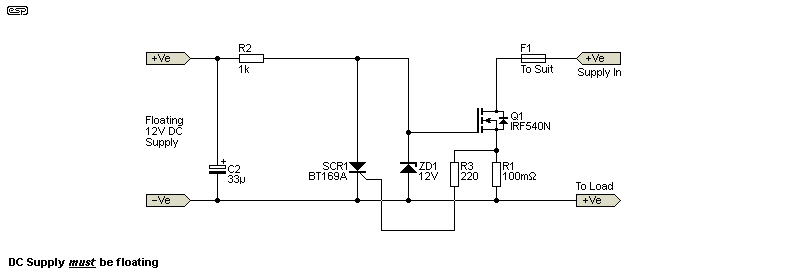
Unlike the Figure 5.1.3 version, once it's triggered, the MOSFET will remain turned off for as long as the auxiliary 12V supply is present. The SCR needs around 6mA to ensure that it remains on once triggered. The circuit also doesn't rely on the MOSFET's on resistance, only that of the current shunt. Once the SCR is triggered, it doesn't require any voltage from the main supply. Note that the MOSFET must be a 'standard' type and must not be logic compatible (turned on with 5V). An SCR is unable to reduce the voltage to much below 1.7V, which may provide enough gate voltage to cause current to flow in the MOSFET if it's a low threshold (logic compatible) type. SCRs are temperature sensitive, so if it gets hot, the detection current will fall. It's unlikely to cause a problem in most circuits.
The reed switch detector shown below can also be used with the above circuit (DC only). There are a few other changes needed. Replace the sense resistor with the reed switch coil, and include the 1k gate series resistor.
The next circuit is very adaptable, but in its simplest form it's flawed. With a few enhancements you can do things that would otherwise be impossible or inadvisable. The detector (reed switch and sense coil) and the relay do not need to be part of the same circuit - the reed switch can sense DC, using the relay to disconnect AC. This makes it highly versatile. While there are ways that other circuits shown can be wired in a similar manner, the following version is the easiest to adapt.

The above e-fuse uses a reed switch with a sense coil, which minimises the voltage drop across the sensing circuit. It's not adjustable, other than by varying the number of turns around the reed switch. As noted above, the switch I tested responded to 20A/T (ampere-turns), so ten turns provided detection at 2A. The load and its supply must be DC to prevent reed vibration and possible metal fatigue. Provided the reed switch terminals are at least 5mm from the coil, the circuit will be safe with mains derived voltages. AC through the sense coil is not recommended, because if the current is high enough the reed will be vibrating constantly.
When DC is applied, the relay is de-energised, and the NC (normally closed) contacts provide DC to the load. When the trip current is exceeded, the relay is energised via SCR1 and disconnects the load. In common with all DC relays, make sure that the voltage is within the relay's DC voltage limit. This is typically only 30V DC for most relays, but it can be doubled by using two sets of contacts in series. I suggest that you read the article Relays, Selection & Usage (Part 1) and Relays (Part 2), Contact Protection Schemes to gain an understanding of the issues faced when switching DC with electromechanical relays.
Note: Using a normally closed relay contact is less than ideal, but it's the only way to get zero dissipation when the system is on standby. 24V operation is quite ok - use a 24V relay and increase the value of R1 to 1.8k. However, there is no protection against contacts that weld closed due to high inrush current into the load. Relays can weld their contacts and MOSFETs can fail (always short-circuit) - no connection/ disconnection scheme is immune from failures.
The same basic arrangement can be used with a MOSFET switch (the gate draws zero quiescent current), and that may be preferable. The SCR simply pulls the gate voltage down to about 1.8V, which turns it off. The gate requires a feed resistor from the +Ve supply (1.8k is fine for 12V) and a 15V zener to ground to protect it against voltage spikes. When triggered, the circuit will draw only 6mA, which is just enough for the SCR to latch and remain turned on. The test button is highly recommended if you use a semiconductor switch.
Although the reed switch I tested required 20A/T, yours will likely be different. Once you know how many ampere-turns are needed, it's easy to calculate the number of turns needed for any given current. For example, the switch I used would need 40 turns to respond to 500mA, 20 turns for 1A, or 5 turns for 4A. The reed switch can be used with many of the other circuits as well, but it will not work with the Figure 5.1.3 version, because that circuit needs the main supply to be present so it can latch.
There are inherent problems with an e-fuse that uses the main supply to power the fuse circuit. The kindest thing we can say about a short circuit is that it's brutal. If you consider the circuit shown in Fig. 5.2.5 you may see the problem. A 'dead short' removes all power, because the supply is shorted. With no DC available, the relay cannot activate, and you'll only get the circuit to work if the main supply is capable of more current than the short circuit can absorb. There is no way to guarantee this, but you might get away with a circuit like that shown next.
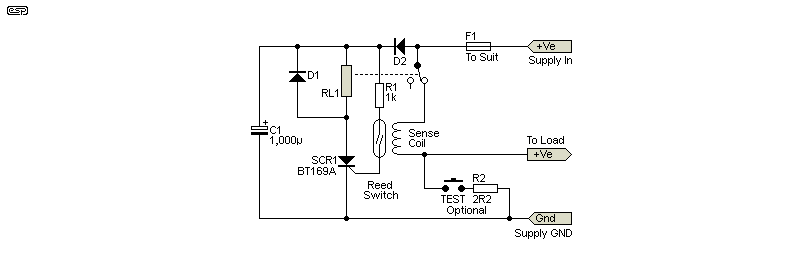
D2 charges C1, which is made much larger than would normally be needed. It has to be able to provide current for the relay coil during the time it takes to disconnect the shorted load. The final value of C1 depends on the relay's coil current, the applied voltage, and the relay reaction time. To be safe, it should be able to hold enough charge to provide the relay with enough current to operate for at least 5 times the expected activation time.
The voltage from the supply will collapse while the short is present, but it should disconnect within around 10ms (based on 'typical' 12V relays). Current to the load is interrupted, but the relay remains energised, keeping the faulty load from causing damage. Of course, a really serious fault current may cause the wire fuse to open, but if that happens, the e-fuse is redundant.
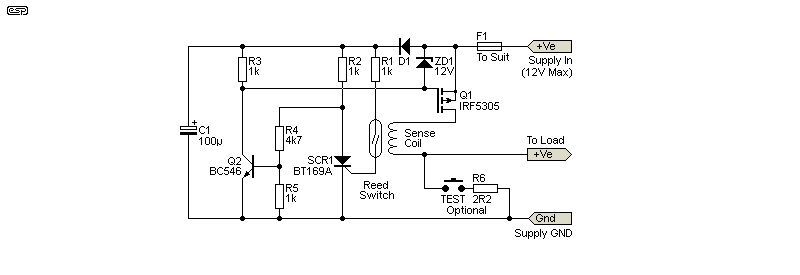
A MOSFET is a good switch - no moving parts and very fast operation. However, like all semiconductors, MOSFETs can be damaged by a variety of abuses. Because we are switching the 'high side' (i.e. the positive supply), a P-Channel MOSFET is needed to eliminate the requirement for a supplementary voltage to drive the gate. The output from the SCR has to be inverted, hence Q2. The voltage divider (R4 and R5) is required because the voltage across the SCR when it's on is about 0.8V - enough to keep Q2 conducting. ZD1 may appear to be redundant, but the gate of a MOSFET must be protected from 'unforeseen' conditions, as may occur if the load is inductive. As you can see, the circuit is more complex, but the added parts are all low-cost.
As long as no overload is detected, the SCR remains off, so Q2 is on, pulling the gate of Q2 to ground, turning it on. When an overload triggers the reed switch, the SCR turns on, removing base drive from Q2. Its output (collector voltage) goes to +12V, and Q1 turns off, disconnecting the load. The load remains disconnected until power is cycled (so the SCR can turn off). A push-button can be used in parallel with the SCR as a 'Reset' switch. The circuit turns on again when the switch is released, so the e-fuse is instantly re-armed. If the fault is still present, it will promptly turn off again.
No part of any e-fuse circuit should ever be taken for granted, and everything has to be tested (many, many times) to ensure that it performs as expected every time. Before you commit to a MOSFET, check that RDS (on) ('on' resistance) will not reduce the voltage too much, and/ or subject the MOSFET to excessive power dissipation. The IRF5305 has a claimed RDS (on) of 60mΩ, whereas a more-or-less typical 10A relay will have (quoted) contact resistance of less than 50mΩ. If you choose to measure it, you'll usually find it's less than that. I've measured around 10mΩ for some relays - there are MOSFETs that can beat that easily, but there are comparatively few low RDS (on) P-Channel types. Lower RDS (on) can be obtained by paralleling two or more MOSFETs. R3 may be reduced so it can discharge the gate capacitance as quickly as possible.
Sometimes, one sees a circuit that looks too good to be true. This is almost always because it is - the 'designer' has completely failed to see the inherent flaw(s). The next drawing is just such a circuit, but I won't say where it came from other than it was a website in India. It has been simplified (LEDs etc. are not included) and redrawn. The demonstration unit used a 9V battery to power a small motor (already a bad combination because of the very low capacity of 9V batteries). The circuit relies on the resistance of the source voltage, and if the supply is capable of 10A or more, the circuit will only operate if the short-circuit impedance/ resistance is very low.
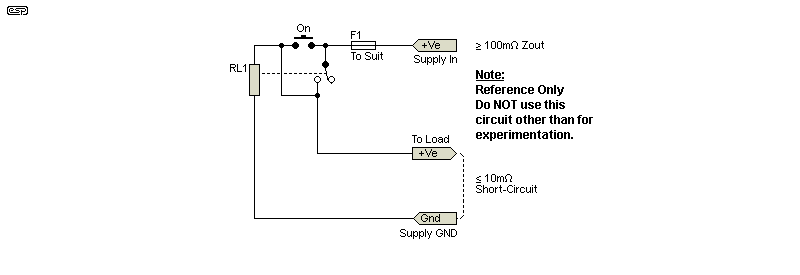
The idea is that you press the 'On' button to turn on your device, and that energises the relay, which bypasses the pushbutton switch. The relay remains activated as long as power is present. The premise is that if the load develops a fault or is short-circuited, the incoming voltage will be pulled to zero (or close enough) and the relay will release. The load (and short circuit) is then disconnected, and everything is (allegedly) protected. Unfortunately, there is no current sensor of any kind, so operation depends only on the fault being able to pull the supply voltage down to less than 1V (for a 12V relay). Any overload that can't reduce the supply voltage to near zero will not de-activate the relay, so the load may burn out, the supply may be damaged, or (probably) both.
As shown with a supply having an output impedance of 100mΩ (implying 10% regulation at 10A which is pretty poor), the 'short' must have a resistance of 10mΩ or less to pull the voltage down to below 1V so the relay will release. Most 12V relays will remain activated with a voltage of as little as 1.2V ¹. The short-circuit current will be around 110A for at least 10ms (the relay release time). Operation is not 'automatic' in that the 'On' button must be pressed to turn the device on. It is possible to make its start-up automatic upon application of power, but the design is so badly flawed that there's no point. Relying on a fault to reduce the supply voltage to zero is not an 'electronic fuse' under any known definition.
I've included this as example of what not to do. When you see circuits on the Net, understand that many are flawed, some won't work at all, and some are downright dangerous. The circuit shown is a perfect example - it's badly flawed, and is potentially dangerous unless the voltage supply has a comparatively high output impedance (preferably at least 1Ω) and can withstand a shorted output without being damaged. Note that the 'On' button must be rated for the full load (or short-circuit) current, and there is no protection while the button remains pressed. The only thing that can save this circuit is a relatively high-impedance source, which renders it useless and dangerous. The wire fuse is my addition - this was not included in the original.
¹ Most relays will pick-up (activate) with 0.8 of the rated voltage (9.6V for a 12V relay) and release at 0.1 of the rated voltage (1.2V for a 12V relay). This is fairly consistent, but always check the datasheet.
There's one circuit that you'll see in any search for 'electronic fuse'. Unfortunately for those who may have built it, they quickly discover that they have just wasted time and parts on a circuit that just does not work for its intended use. The 'theory' is that at a current determined by the base-emitter voltage of Q1 and the value of R2, the transistor will conduct and short out the SCR, which will turn off. These things do not happen. Q1 certainly turns on, because the base is joined to the collector via the SCR. There is nothing that will cause the SCR to turn off!

You'll see that I haven't included any component values, simply because the circuit does only one thing - it wastes parts (and your time). It also reduces the output voltage by around 2-3V so you also need to waste more money on a heatsink for Q1. Over the years, I've seen many forum posts from people who have built this circuit, and they were asking for advice because it didn't work. The only useful advice is don't build it in the first place, because it doesn't work.
There are a few other circuits that may appear similar, but they are current limiters, not fuses. A fuse disconnects the load (and whatever fault exists) from the supply. A current limiter set for (say) 5A with a 12V supply will dissipate 60W if the output is shorted, and obviously a great deal more with a higher voltage or current. Current limiters can be useful at low current (less than 1A), but they don't fully protect the load. If the load is a motor, its internal fan (if fitted) will cool the windings when it's running, but if it stalls (and draws the maximum current allowed for), there is no cooling because the motor is stopped. How long it can survive depends on the power dissipated. This is why true electronic fuses are used!
Finally, this section shows a commercial IC designed for 'hot swap' applications where control is required over everything. This isn't a specific recommendation, but is included to show a sample of what's currently available. There are many others from multiple manufacturers, but this one caught my eye as one of the most ingenious and capable devices I've come across. It's only available in SMD packages.
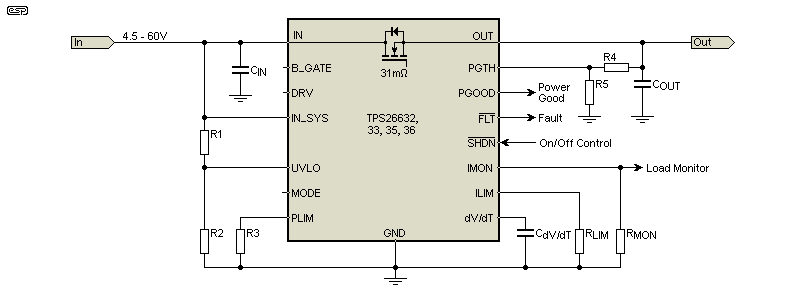
The TPS2663x has just about every bell and whistle you than think of, then adds a few extras. It's primarily designed for 'hot swap' boards in digital systems, and it also features a drive circuit for an external N-Channel MOSFET for reverse polarity protection (this is not included in the above). Every parameter can be programmed using resistors or a capacitor (which controls the ΔV/ΔT (dV/dT) rate of change of voltage over time). It operates using a supply voltage from 4.5V to 60V, and the current limit can be set from 600mA to 6A. TI describes it as a '60-V, 6-A Power Limiting, Surge Protection Industrial eFuse'. It can be set up to automatically re-try or latch off after an overload has been detected. Overvoltage and undervoltage protection are also provided.
This has been included so you can see that e-fuses are now a mainstream requirement, and have abilities far beyond anything described here. However, it comes at a cost. The IC shown is very complex, and is available in LCC (leadless chip carrier) and a 'traditional' SMD package. Both include provision for heatsinking which is necessary when it's in current limit mode. At the time of writing, an evaluation module was available for US$99, with the IC itself costing a little over AU$9.00 for one-off quantities. The datasheet has countless formulae to allow the user to program the various functions. If you need to know more, see the datasheet (and no, I won't answer questions about it - just to save you from asking).
The LTC4249 is another example of an electronic fuse. The details aren't shown here, but it's a dual-channel IC in an LQFN package, which makes it very hard to use for DIY. With 6V to 65V operating voltage (the second channel will work down to 1.5V) at up to 1.2A (which can be doubled by parallelling the two internal e-fuses), it's a very capable IC. The trip current is easily adjusted with a single resistor (per channel), and it's designed to do one job, and do it well.
AC electronic fuses are less common than DC versions. While a few examples exist on the Net, some are best described as ill-conceived, with others that simply will not work as intended. There is no point whatsoever publishing a circuit that doesn't do what's claimed. In some cases, a small change can make all the difference, but most people won't know what to change or why. AC circuits are also tricky, because many common loads have a high inrush current. Because electronic fuses are so fast, the first half cycle can trip the fuse and disconnect the load, even though there's nothing wrong.
This is one reason why fuses (in equipment) and circuit breakers (in the switchboard) remain popular - a slow blow fuse can handle the inrush current easily, but will blow if there's a fault. Circuit breakers (thermal-magnetic types) are available with what's known as a 'D-Curve', which is essentially a delay. A true fault current will trip the breaker, but loads within the D-Curve profile won't. Electronic fuses generally don't allow much leeway, so they will trip at the instant the current exceeds the threshold. I'll only show a couple of AC types, with one using a current transformer and the other a shunt resistor.
Switchboard circuit breakers are almost always thermal-magnetic types. A small overload causes a bimetallic strip to bend as it gets hot, and if the overload is maintained the bimetallic strip will trip the breaker, opening the contacts. If there's a severe overload, the magnetic circuit operates almost instantly, and opens the contacts. Because short circuit current can be very high, an arc is created across the contacts, and this is dissipated with an arc quench system - commonly a series of flat metal strips mounted in an insulating material, that break the arc into smaller segments that are more easily extinguished. This is known as an arc chute. Industrial circuit breakers often use alternative methods that can handle higher voltage and current.
Most AC electronic fuses will be designed to operate if the current is only marginally higher than the required value. Because a short circuit will almost inevitably cause damage or failure, it's important to ensure that an electronic fuse is only ever a secondary system, with the system as a whole protected against catastrophic damage by a fuse or a thermal-magnetic circuit breaker. Relying on electronic circuitry alone is unwise (in the extreme).
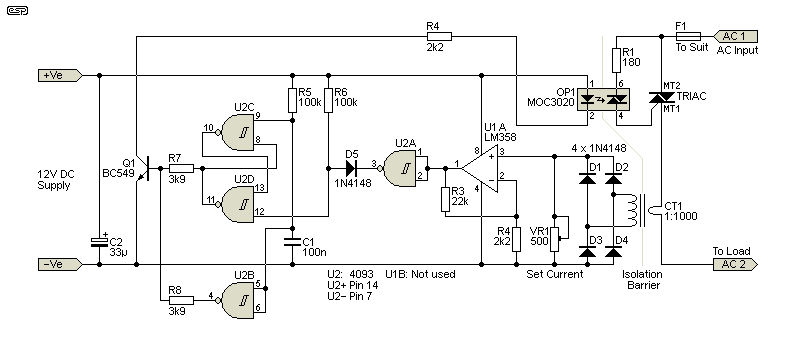
As with the DC version shown in Figure 5.1.1, U2B is used to lock out the output until the power-on reset is complete. If this isn't done, the first cycle can easily be well beyond the threshold, but won't be detected. The current set pot (VR1) may allow the current transformer core to saturate, but that won't impact on the ability of the circuit to detect the current reliably. The MOC3020 is a dedicated TRIAC driver, and provides around 7.5kV isolation between the input (diode) and output (photo-TRIAC). These have been with us for many, many years, and are still available for less than AU$1.00 each. The TRIAC is selected based on the voltage and current required. A common device is the BT139F-600E (TO-220, full pack - no insulator required). These are rated for 600V at up to 16A RMS. You may need some additional circuitry if the load is highly inductive, and the MOC3020 datasheet shows what's needed.
This circuit can be adapted for a slow-blow characteristic using the time delay circuit shown in Figure 5.1.2. As it's shown here, the circuit responds to the peak current, and adding the R/C network means it responds to the average. The time delay can be selected to suit your application, and requires thorough testing to ensure that it can allow for inrush current, but operates as expected with the normal AC load.
For the current transformer, it's hard to beat the AC-1005, a 5A, 1:1000 ratio transformer. It's capable of working at up to 60A, and I've used them in quite a few projects. Of course, there are others, with some small ones (18 x 10 x 18mm) from eBay that are as cheap as chips. I've tested them, and they work perfectly. The sensitivity of any current transformer can be increased by winding two or more turns through the centre. For example, using two turns doubles the sensitivity. In conjunction with the current setting trimpot, this gives a very wide trip range.
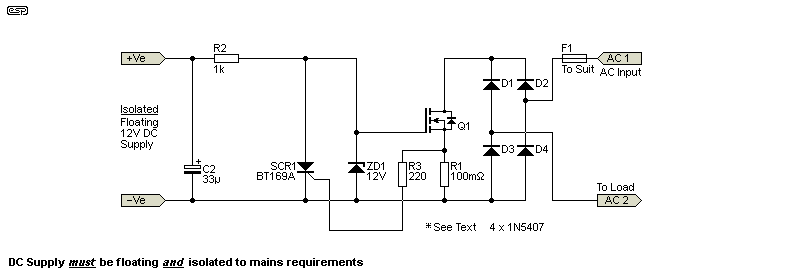
The Figure 5.2.2 circuit is included primarily to show another option, but it's absolutely not recommended for mains unless you know exactly what is required to ensure safety. All circuitry (including the 12V supply) would be at mains potential, so the circuit could be lethal if any part is touched while it's connected to the mains. Simply ensuring that the 12V supply is isolated to full mains insulation requirements is difficult, so my recommendation is not to mess with it. However, it can be used safely at lower voltages, such as in the secondary side of a mains transformer. The diode bridge and MOSFET need to be capable of handling the full load current and peak voltage.
There is no provision for delayed action, so if the load current exceeds the trip current, it will turn off. The excursion only needs to be very brief (less than 1 millisecond is more than enough), so it can't handle inrush current as capacitors charge. Neither AC electronic fuse is recommended unless you have a definite requirement for a switch that operates at relatively low current, and you know exactly how your load behaves when AC is applied.
Finally, I'll end this with another version of the detector shown at the beginning - a reed switch and a power relay. It's suitable for low voltage, particularly automotive or marine applications. Once the reed switch closes, that triggers SCR1, which connects the bottom of the relay's coil to ground. D1 absorbs the relay coil back-EMF when power is interrupted. The difference between this version and the one shown in Figure 5.1.5 is that the relay is normally not energised, and the normally closed contacts are used for the load.
As long as the power is available, the circuit is ready to operate. This may be useful for circuitry that's on continuous standby, as the trigger circuit draws zero power unless a fault is detected. This is often particularly important for battery powered equipment, where continuous drain will discharge the battery. Once triggered it will draw power, and ideally it will also be hooked up to an alarm of some kind that will alert you to the fault. Unfortunately, you don't have confirmation that the circuit is functional because it draws no power unless tripped. However, it's a very simple circuit and there isn't much that can go wrong. Adding a test button would be a good idea, with R2 selected to draw about 1.5 times the normal load. The button must be able to handle the current!
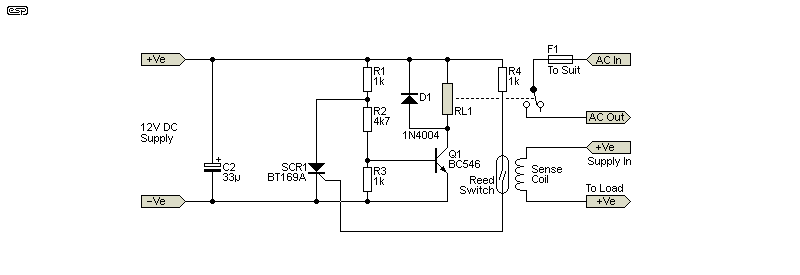
Figure 5.2.3 is a hybrid, in that it detects a DC fault, but disconnects the AC supply. The sense coil is simply wound around the outside of the reed switch as shown in Figure 3.1. The number of turns needs to be determined for the reed switch you use. With just a reed switch, a standard relay that can handle the voltage and current, an SCR, capacitor, resistor and a diode, you have a latching electro-mechanical fuse. It will be far more predictable than a wire fuse, and will operate almost instantly if there is a problem. I would expect that this arrangement would be useful where everything can run from a 12V battery, but it can be used with mains provided the reed switch and relay contacts are fully protected from contact. Do not use AC across the sense coil, because continuous vibration will shorten the life of the reed switch.
Normal operation is started when the 12V supply is turned on, which energises the relay (RL1), closing the contacts and providing AC power to the circuit. Should the load current exceed the limit determined by the number of turns around the reed switch, it closes and SCR1 shorts the supply to Q1, turning it (and the relay) off. The 12V supply does not need to be floating because both the input (detector) and output (relay) are isolated, both from each other and from the 12V supply.
R1 provides sufficient latching and holding current for the BT169 SCR, while R2 and R3 form a voltage divider to ensure that Q1 will turn off when the SCR turns on. R4 provides the gate current for the SCR, and delivers more than enough to ensure it turns on reliably. I've included this because it's interesting, and because it's one of the few e-fuse configurations that can use different sense and control circuits.
When the load current causes the reed switch to close, that triggers SCR1 which energises RL1. The contacts disconnect the load. Because the reed relay will release almost the instant current stops flowing, SCR1 is required to ensure that RL1 latches. You must test this thoroughly, as it's important to ensure that operation is 100% reliable. The backup wire fuse is essential!
While not technically an electronic fuse, a so-called crowbar circuit ensures that a wire fuse operates almost instantly. These circuits get their name from the analogy of dropping a crowbar across a pair of wires, creating close to a dead short. They've been around almost as long as electronics, but became affordable once high-current SCRs were available. One of the first transistor amplifier designs I built had a crowbar protection scheme, but the original designer (who shall remain nameless) failed to run proper tests. When the crowbar circuit operated, it short circuited the (single) supply, so the speaker coupling capacitor had to discharge through a reverse biased output transistor. The results were predictable - the amp blew up, killed by its own 'protection' circuit.
Although I managed to get the amplifier working as it should, the design was flawed elsewhere as well, and was quickly abandoned. It was that which started me on amplifier design, and I haven't stopped since. However, this doesn't detract from the fact that crowbar circuits can be extremely useful. If you use a crowbar, you must ensure that the remainder of the circuit is protected from the crowbar itself. This isn't always as simple as it may seem.
Crowbar protection is often found as part of power supplies expected to operate complex and expensive circuitry that cannot tolerate any significant over-voltage. For example, a processor and support ICs may operate at 5V, but with an absolute maximum of 7V (typical of TTL for example). The crowbar trip voltage may be set for 5.5V, so if the power supply regulator fails and tries to provide a higher voltage, the crowbar circuit operates and protects the circuitry.
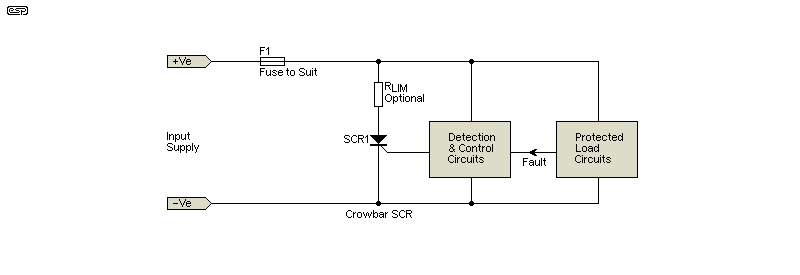
The above shows a basic crowbar system, using an SCR. The control circuitry (shown in block form) can be triggered by any event that puts the protected circuitry at risk. This may include damaging overvoltage, over current, or any other risk factor that may exist. A crowbar circuit is brutal and totally unforgiving, so it's a technique that should only ever be used where the overriding requirement is to protect the load equipment. One example of this is to protect a loudspeaker system from an amplifier fault. If accidentally triggered, the crowbar will most likely cause additional damage to the amplifier, but this may be considered 'trivial' compared to protecting the speaker system. There is one (and only one) project that uses this technique, namely Project 120.
The resistor marked as RLIM is optional, and may be necessary to limit the peak current to something that may not be especially sensible, but at least is not destructive. A very heavy-duty wirewound resistor would be used, which must be capable of handling the peak current without going open circuit. Typical values would range from 0.1Ω up to perhaps 1Ω for high voltage circuits. For example, with 1Ω and a 100V supply, the peak current is limited to 100A. I know through testing that many 'cement' block type resistors cannot handle that much current (they go open, sometimes splitting the ceramic case!), so something designed for the purpose will be required.
The SCR has to be able to handle the normal operating voltage (with some headroom to allow for transient events), and a peak current handling capacity that depends on the supply and the fuse rating. For high current applications, the fuse should be an HRC (high rupturing capacity) type, as it may need to interrupt a significant current. HRC fuses use a ceramic tube instead of glass, and contain sand or ceramic powder which extinguishes the arc much faster than an ordinary glass fuse. It can be instructive to see a glass fuse that's been blown by a mains short circuit - the inside of the glass is covered in a metal film created when the fuse wire vaporises as the arc is drawn. Sometimes the glass will shatter due to localised heating. HRC fuses remain intact even after the most serious short circuit.
Overall, this isn't a technique I'd advise for general usage, because it is so brutal and unforgiving. However, no discussion of electronic fuses would be complete without including it. A crowbar may not be a fuse per se, but it is designed to protect equipment from damaging outside problems. These can include high voltage spikes on the AC line that may damage equipment if not caught quickly, and a crowbar can be designed to be very fast indeed. An SCR like a CS45-08 is rated for an instantaneous current of over 500A, and 800V peak, with a turn-on time of 1kV/µs. They cost less than AU$10.00 each, so you get a great deal of protection for the money. The hard part is in the innocuous little box that says 'Detection & Control Circuits'. What's inside that box depends on the application.
There are countless SCRs available, and there's bound to be one that suits your application. It's essential that you understand the datasheet and the specific limitations that apply to all thyristors. In particular, the gate current must be maintained until the rated holding current is reached. This is rarely a problem with crowbar circuits.
If your application is AC you'll use a TRIAC, and there are additional considerations. In particular, beware of the polarity of the trigger pulse. The recommendation is that if you can only provide a single polarity trigger pulse, it should be negative, as this avoids the potentially troublesome '3+' quadrant, where MT2 is negative and the gate is positive. (TRIAC terminology refers to 'MT1' (at the gate end of the device) and MT2 - 'MT' stands for 'main terminal'. The remaining terminal is the gate. These are shown in Figure 5.2.1.) Further discussion of this is outside the scope of this article. AC crowbar circuits are relatively uncommon.
Where equipment is powered from dual supplies, they usually get annoyed if one supply rail disappears but the other remains. This depends on the circuit itself, but it's common for a power amplifier circuit to 'go DC' if one supply rail should disappear. DC can easily damage speakers, hence the need for projects such as Project 33. With an electronic fuse, it's usually possible to arrange the circuitry so that if one supply draws more than the rated current and trips, it will trip the opposite polarity (or even another voltage of the same polarity if both are needed for normal operation).
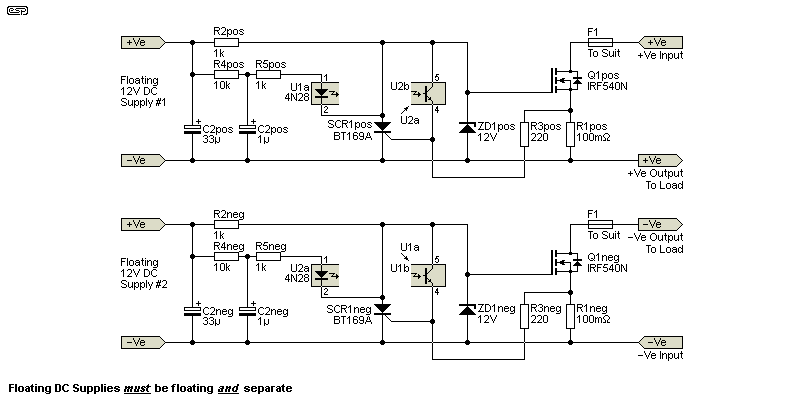
In the circuit shown, there are two optocouplers, U1 and U2. The output sides of each connect to the opposite polarity supply. If either SCR operates, it activates the optocoupler, and the output trips the other supply. It doesn't matter which one operates first, both will trip within a few milliseconds of each other. Note that the negative supply cannot share the 12V auxiliary supply - it must be separate from the supply used for the positive e-fuse circuit.
While the above is shown using the Figure 5.1.4 circuit, the same principle can be applied to most of the other circuits. The negative supply connections might look 'odd', but remember that the N-Channel MOSFET doesn't care about the external polarities, only that its drain must be more positive than its source. Provided that the voltage polarity is correct, the circuit works as expected.
Where (low current) SCRs are shown, there's no real reason that you can't use a 'discrete' version, using one NPN and one PNP transistor and a resistor plus diode (or two resistors). The arrangement shown below is almost identical to a 'real' SCR. However, it has one important (and potentially useful) function - it can be turned off by applying a negative gate voltage. This doesn't work with standard SCRs - once turned on, the only way to turn them off again is to reduce the current below the SCR's holding current. The turn-off pulse needs to be significantly greater than that used to turn the device on. It only needs about 1mA to turn on, but requires around 5mA to turn off with the values shown. Higher anode current means that more current is required to turn it off. While marginally interesting, the ability to turn it off is not particularly useful. This type of device is known as a GTO (gate turn-off) thyristor, and they are available as a single component (albeit not particularly common).

In the discrete SCR circuit, D1 is used to convert the upper transistor to a current mirror, and that reduces the 'on' voltage, as well as the base current in both Q1 and Q2. You can use another 1k resistor instead of D1, but the circuit doesn't work as well, with the base current being far greater in both transistors (by a factor of at least five). The circuit operates as a regenerative feedback amplifier. Once either transistor starts to conduct, it supplies base current to the other, turning on very quickly. As simulated, the turn-on time is not much over 200ns, which is pretty fast by any standard. As tested on the workbench, that time fell to just over 8ns, and the circuit was triggered from an ohm meter (as tested its output was under 1mA).
The discrete SCR is included for two reasons. Firstly, it demonstrates the internal structure of an SCR rather well, plus the discrete SCR provides the experimenter with an easy way to play with the circuit to see how it works. It can also be used if you don't have any low power SCRs in stock, but it is not designed to handle more than a few milliamps. I'd suggest that anything more than 100mA is being 'adventurous', largely because it pushes the base circuits close to their current limits. The real SCR and its discrete counterpart are similar in performance at low current. Both require an input current on the gate (G) terminal, and both require a defined holding current.
The discrete version is more sensitive, but can handle less voltage and current than the BT169A shown. D1 can be replaced by another 1k resistor, but that forces the base current to be a great deal higher than with the version shown. It will also have a higher saturation ('on') voltage, by about 100mV at 12mA or 750mV at 100mA. Be warned that the discrete SCR is very sensitive, and simply connecting the supply will often cause it to trigger. The risetime of the applied DC should be controlled to prevent false triggering, or use a 10nF cap in parallel with the 'SCR' itself.
The two transistor latch (bistable) circuit is another alternative. It's useful anywhere you need to latch a condition (such as an over-current 'event'). The standard approach is to connect a capacitor from the supply to the base of one transistor, which forces a reset. This sets the circuit to a known condition when power is applied, and it will remain in that state until a pulse is applied to the 'G' terminal (actually 'trigger', but I used the same terminology as used in the other circuits). Unfortunately, the capacitor also slows down the switching speed, but not usually to a significant degree.
This circuit has been around from before the earliest days of transistors (using valves/ vacuum tubes), and could be used to replace the pair of cross-connected NAND gates shown in Figures 5.1.1, 5.1.2 and 5.2.1. Despite its simplicity, it will use more PCB space than the IC, and will probably cost more as well. However, it's an important building block in electronics. In logic terminology, it's called a 'set/ reset' (or just S/R) latch (aka 'flip-flop'). It's one of a 'family' of what are known as multivibrator circuits. The other two are the astable (no stable states, an oscillator) and monostable (one stable state, commonly used as a timer).
In several of the circuits described above, a reed switch was used as a current sensor. These are fine for DC, but not with AC, as the reed will vibrate constantly and metal fatigue will eventually cause mechanical failure. There are Hall-effect sensors that are designed to provide a linear output with applied current, and these can be used to detect AC or DC. These have an isolated output (no electrical connection to the current-carrying conductor), and they almost always use a 5V supply with a no-load output of 2.5V (allowing positive and negative output depending on load supply polarity).
One example is the Allegro ACS712. Different models are available to detect current from ±5A to ±30A. The 5A version has an output voltage (referred to 2.5V) of 185mV/A, so a 5A load current will cause the output level to be ±925mV. Higher current versions have a lower sensitivity to ensure that the output voltage doesn't exceed ±2V, as it must remain within the 5V supply limit.
These devices are effective and convenient, with a claimed isolation voltage of 2.1kV RMS, so mains voltage detection is allowable, with the detection and trigger circuitry at low voltage. They are comparatively expensive (you can get current transformers for less money), but are a great deal smaller. Unfortunately, they're only available in SMD packages, and while they have wide bandwidth they are also rather noisy.
The wide bandwidth makes them suitable for instantaneous monitoring of switchmode power supplies operating at less than 80kHz. Because the output requires further processing (amplification and rectification for AC), they are more complex to implement, and I've not included any example circuitry in this article. The datasheet shows a number of application circuits, and these can be used to work through to a complete e-fuse solution.
The circuits shown above quite deliberately specify through-hole parts wherever possible, and use well established parts that have been around for a long time. As a great believer in making things that can be repaired should something go wrong, I avoid SMD parts because most people find them very difficult to work with, and they make the end product very hard to work on later should it ever need fixing. The idea of 'throw it away and get a new one' doesn't sit well with me, and I firmly believe that if something is still capable of doing its job, it should be fixed if it ever fails.
The circuits shown will all work as claimed, even though this is not intended as a collection of projects. The idea is to show budding constructors their options, and stimulate thought about how a circuit functions. Not all of the circuits have been built and tested, but all have been successfully simulated, and function as intended in the simulator. Of course, 'real life' can throw up some potential glitches, but these have been addressed where misbehaviour is a possibility.
Each circuit shown has parts that can be mixed and matched to suit the application. For example, a current transformer can drive an opamp with the output used to trigger a small SCR. Likewise, you can use the opamp and 4093 CMOS latch circuit (Figures 5.1.4, 5.1.5 and 5.2.2) where an SCR is shown. When opamps are used with a single supply, I suggest the LM358, because it's available almost anywhere, is low power, it can function with the inputs at the negative supply voltage, and the output can get to (almost) zero volts. Most opamps can't. There are other alternatives to the LM358, but most are likely to be less readily available and more expensive.
In most cases there is no requirement for electronic fuses. While it is a technique that can be applied to particularly sensitive systems, in the field of audio it's rarely necessary. An electronic fuse using a reed relay or current transformer may seem easy ways to detect excess output current from a power amplifier (indicating a short circuit or a load impedance that's below the optimum), but the reed relay won't respond to high frequencies, and a current transformer won't respond to a DC fault. You can use both of course, and the extra impedance in the speaker output won't affect the amp's output impedance.
However, music is dynamic, and the impedance of a loudspeaker is rarely a 'simple' load. Amplifier protection circuits (e.g. VI limiters) are more likely to protect the amplifier from an unfriendly load, but they aren't without their problems either.
It should be obvious that if you need a really good electronic fuse, it's not a simple undertaking. There are many different e-fuse ICs available that are designed to protect sensitive equipment, although I've only shown a single example. There is no way that I could cover them all as there are so many. The one shown gives you an idea of the capabilities that users expect.
The DIY circuits shown are also only examples. I've shown MOSFETs in most cases, but you can also use IGBTs or bipolar transistors for switching DC. In most cases, a TRIAC is the easiest way to switch AC, but they will not turn off partway through a half cycle, only when the current falls below the holding current. While this may allow a very high peak fault current, it's brief and (probably) won't cause further damage. For AC switching, a MOSFET relay (see Project 198) may be a good option, but I do not recommend using it with mains voltages.
In all cases, the switching device has to be selected based on the voltage and current that is to be controlled. Suitable devices are readily available, with many capable of very high voltage or current. Expecting high voltage and high current usually means the switching device will be expensive, but this isn't often a requirement for DIY projects. The nice thing about an electronic fuse (apart from its well defined cutoff current) is that they are much faster than wire fuses, and can operate even at very low currents. While a 10mA fuse isn't a common requirement, it's easy to do with electronics, but a great deal harder with a wire fuse (try buying a 10mA fuse - they exist, but the price will probably scare you away).
The advantages of electronic fuses are that they are much faster than wire fuses, and can be made to trip quickly with even a small overload. The disadvantages are greater cost and complexity, so they will not be an economical proposition for anything but the most demanding of applications. While the level of protection is far greater than a wire fuse can provide, the wire fuse is still essential in most cases, simply because an e-fuse uses electronics components which can fail. All circuits (other than Figure 5.1.6) are shown with wire fuses, which act as a final backup should a fault develop in the e-fuse. It would (IMO) be most unwise to leave these out, because you may end up with no protection at all.
I've not referenced any of the circuits I found on-line. While there are a couple that appear to be well thought through, most are a motley mixture of continuously regurgitated circuits of unknown origin, and in some cases just won't work at all.
 Main Index Main Index  Articles Index Articles Index |